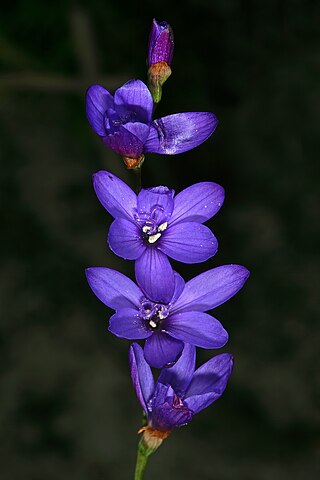
Namaqua National Park is a South African national park situated approximately 495 km north of Cape Town and 22 km northwest of Kamieskroon. It has an area of more than 1300 km2. The park is part of Namaqualand, an area covering 55,000 km2 located within the semi-desert Succulent Karoo biome. This biome is a biodiversity hotspot with the largest concentration of succulent plants in the world. The park also has an arid environment with succulent plants. The park was created to protect its flowers. During the spring, wildflowers bloom there in a spectacular fashion. The park's main tourist attraction is this abundant spring bloom of brightly coloured wildflowers.

Moraea aristata is a species of flowering plant in the family Iridaceae. It is referred to by the common names blue-eyed uintjie or Blouooguintjie in Afrikaans.It is endemic to the city of Cape Town and is considered to be critically endangered.

Geissorhiza aspera, also known as the blue satin flower or blou sysie, is a geophyte from South Africa.
Lobostemon echioides, the common healthbush, is the mostly widely distributed species in its genus. It is endemic to South Africa, where it is found growing between Namaqualand and the Karoo and the Eastern Cape.
Ursinia punctata is a species of plant belonging to the daisy family. It is found growing in South Africa, where it has a wide distribution.
Felicia deserti is a species of plant from South Africa. It belongs to the daisy family.
Acrodon caespitosus, the Potberg tiptoothfig, is a species of mesemb from South Africa.

Cheiridopsis speciosa is a species of plant from South Africa.
Cheiridopsis schlechteri is a species of plant from South Africa. It is a succulent plant that grows in dry habitats.
Cheiridopsis turbinata is a succulent plant from South Africa.
Cheiridopsis umbrosa is a succulent plant from South Africa.
Cheiridopsis purpurea is a species of succulent plant from South Africa. It is found growing in the succulent Karoo vegetation type.
Cheiridopsis umdausensis is a species of succulent plant from South Africa.
Cheiridopsis velox is a species of succulent plant from South Africa.
Cheiridopsis ponderosa is a species of succulent plant from South Africa.
Senecio sophioides is a species of plant from South Africa.
Nemesia glaucescens is a species of plant endemic to South Africa. It belongs to the figwort family.
Hebenstretia kamiesbergensis, the Kamiesberg slugwort, is a species of plant from the Kamiesberg Mountains in South Africa. It belongs to the figwort family.

Heliophila africana, the African sunspurge or little blue mouth, is a species of plant from South Africa.

Lachenalia unifolia, the banded viooltjie, is the most common Lachenalia species in the Cape Floristic Region of South Africa.





